Many people believe all insects are harmful, but that’s a myth. Beneficial insects like ladybugs control pests, while bees and wasps pollinate plants and manage pests naturally. Dragonflies reduce mosquito populations, and termites help recycle dead plant material. Parasitic wasps support sustainable farming by targeting specific pests. Understanding these facts shows that not all insects are pests—many play crucial roles in maintaining healthy ecosystems. Keep exploring to discover how these insects truly benefit you.
Key Takeaways
- Not all insects are pests; many, like bees and ladybugs, provide essential ecological benefits.
- Insects such as termites play vital roles in nutrient recycling, contrary to the myth they are solely destructive.
- Beneficial insects naturally control pests, reducing the need for chemical pesticides in sustainable agriculture.
- Bees generally sting only when threatened, and most are gentle; wasps can sting repeatedly and may pose higher risks.
- Eliminating all insects can harm ecosystems, biodiversity, and crop productivity, highlighting their importance beyond pests.
Common Misconception: All Insects Are Harmful
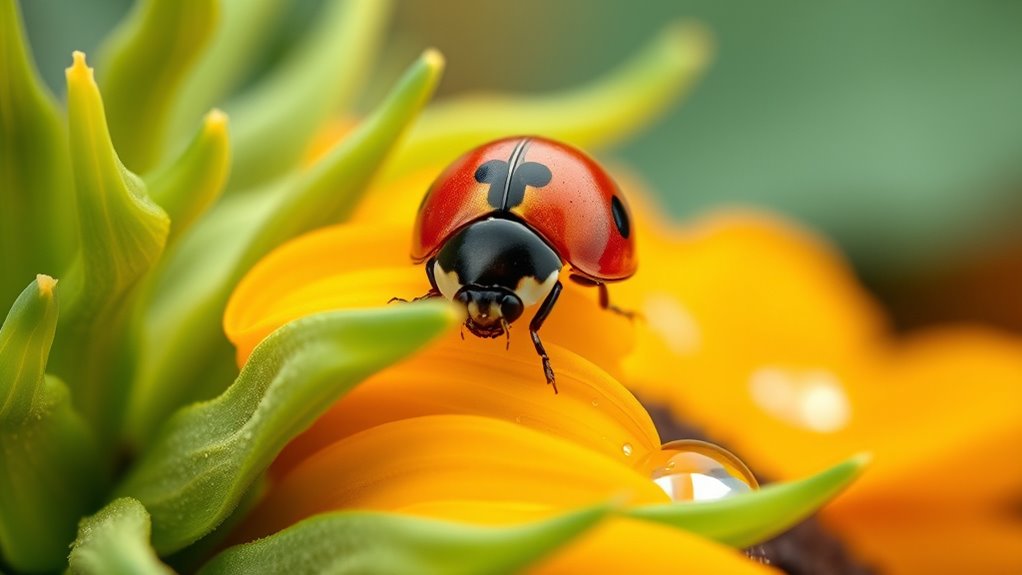
Many people believe that all insects are harmful, but this isn’t true. Insect diversity is immense, with thousands of species playing essential roles in ecosystems. Many insects contribute positively to pest management by naturally controlling pest populations, reducing the need for chemical pesticides. Beneficial insects like pollinators help plants reproduce, supporting agriculture and wild plant growth. Understanding that not all insects are pests allows you to appreciate their ecological importance. Recognizing the difference between harmful pests and helpful insects is crucial for sustainable pest management strategies. Instead of fearing every insect, learn to identify those that support your environment and crops. This knowledge helps promote a balanced view, emphasizing that many insects are allies rather than enemies in maintaining healthy ecosystems. Additionally, some beneficial insects are involved in ancient agricultural practices, highlighting their longstanding importance to human food systems.
The Truth About Ladybugs and Their Pest Control Role
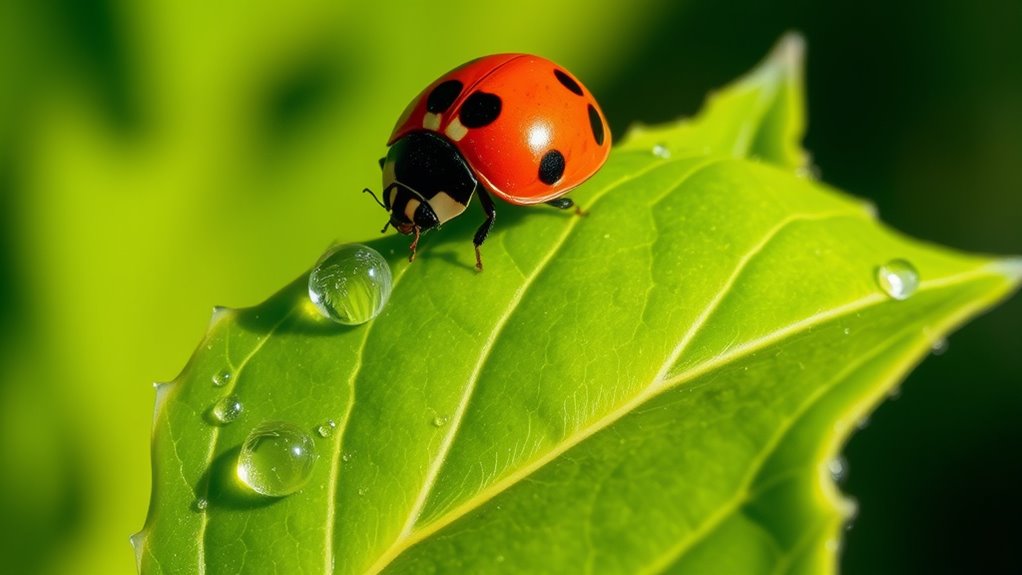
Ladybugs are often celebrated as natural pest controllers, and for good reason. Their benefits include feeding on aphids, scale insects, and other pests that damage plants. When you see ladybugs in your garden, you’re witnessing a natural form of pest control that reduces the need for chemical pesticides. Ladybug benefits extend beyond pest suppression—these insects are harmless to humans and plants, making them an eco-friendly solution. By encouraging ladybug populations, you support a balanced ecosystem and promote healthy plant growth. Keep in mind, ladybugs focus on pest insects, so they won’t harm beneficial insects or your crops. Overall, ladybugs play an essential role in pest control, offering a safe, effective, and sustainable way to manage garden pests. Understanding their role in integrated pest management can help gardeners make informed decisions about natural pest control methods.
Bees vs. Wasps: Debunking the Allergy and Aggression Myth
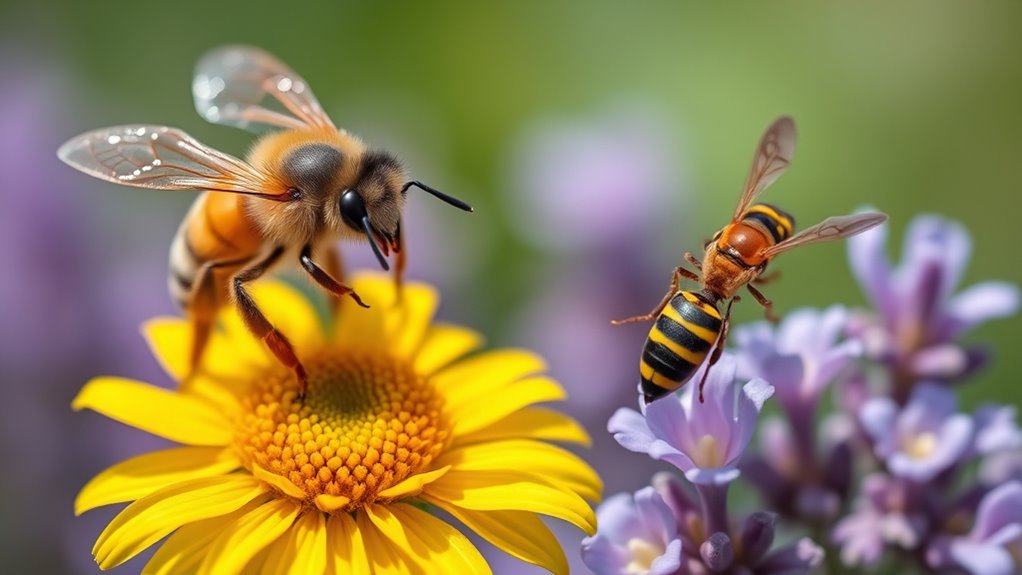
Many people assume bees and wasps are equally aggressive and dangerous because of allergy risks, but that’s not true. Bees are generally gentle and only sting in self-defense, while wasps can be more aggressive but rarely cause serious allergies. Understanding these differences helps you avoid unnecessary fear and appreciate their roles in nature. Additionally, best anime movies showcase diverse storytelling styles that can also help us better understand different species and their behaviors.
Allergy Risks Compared
While both bees and wasps can sting, their allergy risks and levels of aggression are often misunderstood. Bees tend to sting mainly when defending their hive, but their stings usually cause allergic reactions in sensitive individuals. Wasps are more aggressive and more likely to sting without provocation, increasing allergy risks. Understanding these differences is key to effective pest prevention and managing allergic reactions.
- Bees generally sting only when threatened, reducing unnecessary allergy risks.
- Wasps can sting multiple times, raising the chance of allergic responses.
- Allergic reactions vary widely, from mild swelling to severe anaphylaxis.
- Proper pest prevention minimizes encounters and sting incidents.
- Recognizing the insects helps you seek immediate treatment if allergic reactions occur.
Aggression and Defense
Understanding the differences in aggression between bees and wasps can help you better navigate encounters and reduce risks. Bees tend to be less aggressive unless their hive is threatened, relying on insect communication to alert others of danger. Wasps, however, are more territorial and use defensive strategies that include aggressive stinging when disturbed. Bees usually defend with a single sting and then die, while wasps can sting multiple times. Recognizing these behaviors allows you to stay calm and avoid provoking either insect. Remember, their aggression is often a response to perceived threats, not unwarranted hostility. By understanding their defensive strategies, you can minimize risks during outdoor activities and appreciate these beneficial insects’ roles in ecosystems. Additionally, learning about water park amenities can ensure a safe and enjoyable experience when encountering outdoor environments.
Dragonflies: Nature’s Mosquito Exterminators
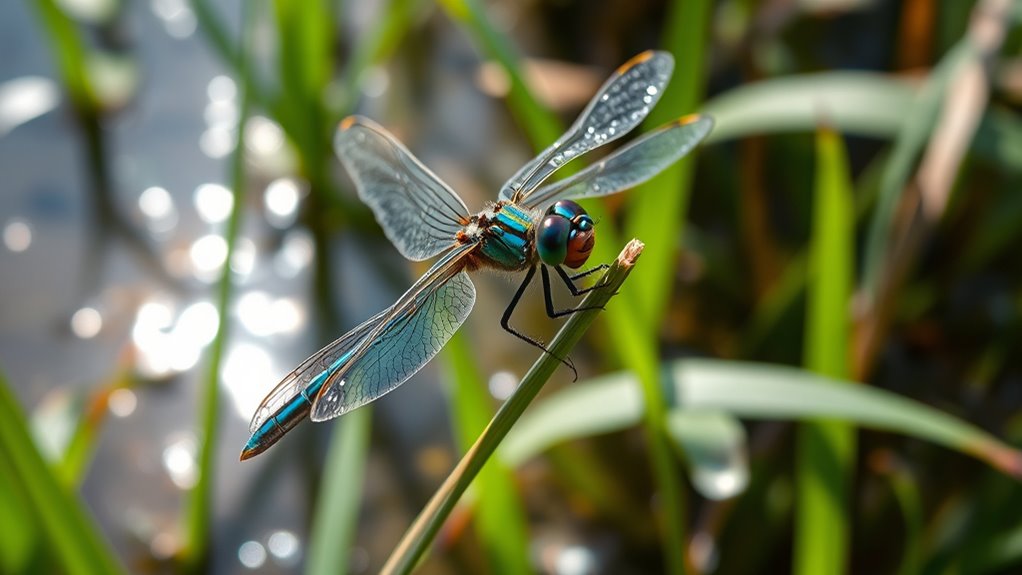
Dragonflies are powerful mosquito hunters, often consuming dozens of insects daily. As natural predators, they help control mosquito populations without chemicals or effort on your part. Their presence also supports healthy ecosystems by maintaining a balanced insect community. Promoting environmental balance through natural predators like dragonflies can enhance overall ecosystem health.
Mosquito Control Power
Did you know that dragonflies are some of the most effective natural predators of mosquitoes? They can substantially reduce mosquito populations, helping you enjoy outdoor spaces without constant bites. Beyond their mosquito control power, dragonflies contribute to insect diversity and support pollination benefits in ecosystems. Their presence indicates a healthy environment with balanced insect populations. By encouraging dragonflies, you’re promoting a natural, chemical-free method of pest management. These insects can consume hundreds of mosquitoes daily, making them crucial allies in maintaining a balanced backyard ecosystem. Their role extends beyond pest control, fostering pollination and supporting overall biodiversity. Creating water features or planting native vegetation can attract them, enhancing their presence in your outdoor space. Embracing their presence helps reduce reliance on chemical insecticides and enhances the natural harmony of your outdoor space.
Natural Predators at Work
When it comes to natural mosquito control, dragonflies stand out as some of the most effective predators in your backyard. They play a vital role in pest management by preying on mosquito larvae and adults, considerably reducing their populations. Dragonflies are skilled hunters, with their insect behavior optimized for catching flying prey mid-air. Their swift flight and sharp eyesight make them efficient mosquito exterminators, naturally balancing local insect populations. By supporting habitats that attract dragonflies, you help harness their predatory instincts in your yard. This not only lowers mosquito numbers but also minimizes the need for chemical interventions. Understanding their insect behavior helps you create a more balanced ecosystem, where beneficial insects like dragonflies contribute to keeping pests in check naturally.
Benefits to Ecosystems
Supporting dragonflies in your yard not only helps control mosquitoes but also benefits the broader ecosystem. These insects contribute to maintaining ecological balance and support various environmental processes. Dragonflies aid pollination processes by moving between plants, enhancing plant diversity. Their presence also promotes soil aeration, as their larvae burrow in the sediment, improving soil health. Additionally, they serve as prey for birds and other wildlife, supporting food webs. By controlling mosquito populations, they reduce disease spread and lessen the need for chemical pesticides. Their role fosters a healthier, more resilient ecosystem where plant and animal life thrive. Promoting ecological balance encourages a sustainable environment, supporting biodiversity and natural environmental functions.
Myths Surrounding Termites and Their Ecological Importance
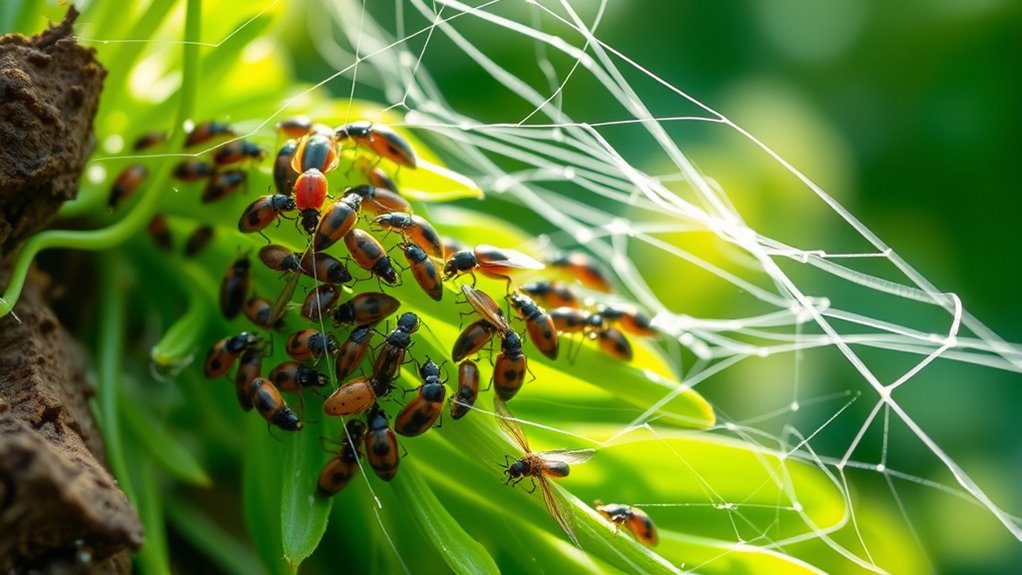
Many people believe that termites are solely destructive pests, but in reality, they play a crucial role in ecosystems by breaking down dead plant material and recycling nutrients. This is a key aspect of termite ecology, highlighting their importance in maintaining healthy soil and plant growth. Despite common myths, termites contribute to insect biodiversity by supporting various organisms that depend on decayed wood and plant matter. Their activities help aerate the soil and foster nutrient cycling, which benefits entire ecosystems. Recognizing these ecological functions challenges the misconception that termites are only harmful. Instead, you should recognize their vital role in sustaining balanced environments. Understanding the ecological functions of termites reveals how they enhance biodiversity and ecosystem resilience, rather than just causing damage.
The Benefits of Parasitic Wasps in Agriculture
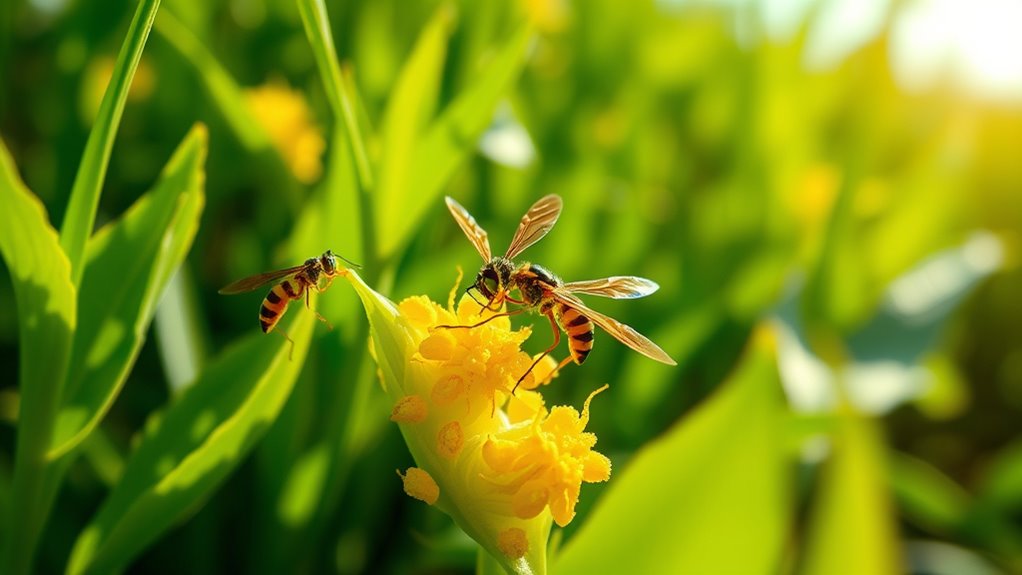
Parasitic wasps offer significant benefits in agriculture by naturally managing pest populations. These tiny insects target specific pests, reducing the need for chemical pesticides. By using parasitic wasps, you support eco-friendly pest management strategies that promote healthier crops and environments. They lay their eggs inside pest insects, which then hatch and kill the host from within. This precise action minimizes harm to beneficial insects and ecosystems. Additionally, their ability to target specific pests makes them a highly selective control method, reducing unintended impacts on non-target species. This precise action minimizes harm to beneficial insects and ecosystems.
- Control common pests like aphids and caterpillars
- Reduce reliance on chemical pesticides
- Promote sustainable farming practices
- Support biodiversity in agricultural settings
- Offer long-term pest management solutions
Incorporating parasitic wasps into your pest management approach can boost crop yields and reduce environmental impact, making them invaluable allies in sustainable agriculture.
Why Not All Insects Should Be Eliminated
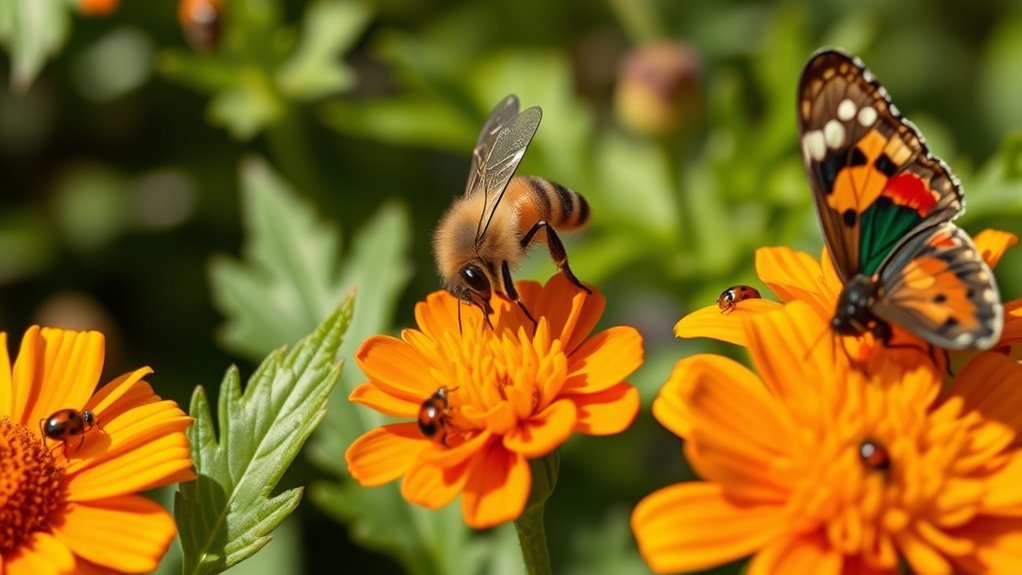
Not all insects are harmful; in fact, many play essential roles in maintaining healthy ecosystems. Insect pollination allows plants to reproduce, supporting food production and biodiversity. Without pollinators like bees and butterflies, many fruits, vegetables, and flowers wouldn’t thrive. Additionally, insects contribute to soil aeration through their burrowing activities, which helps improve soil quality and promotes healthy root growth. Eliminating all insects could disrupt these crucial processes, leading to decreased crop yields and degraded ecosystems. While some insects can be pests, most are beneficial and necessary for balance in nature. Instead of eradication, we should focus on managing harmful populations and protecting beneficial insects that sustain the environment and our agricultural systems. Recognizing the importance of AI safety measures can help ensure that technological advancements support ecological and societal stability.
Frequently Asked Questions
How Do Beneficial Insects Affect Native Ecosystems?
Beneficial insects positively affect native ecosystems by supporting pollinator diversity, which enhances plant reproduction and ecosystem health. They help control invasive species by preying on pests that threaten native plants and animals. By maintaining a balanced insect population, you guarantee native species thrive, reducing the risk of invasive species dominating. This natural pest management and pollination bolster overall biodiversity and ecosystem resilience, making your environment healthier and more sustainable.
Are There Safe Ways to Attract Beneficial Insects to Gardens?
Yes, you can attract beneficial insects safely by using companion planting and considering seasonal timing. Plant flowers like marigolds or dill alongside your vegetables to lure pollinators and predators. Additionally, stagger planting times to match their active seasons, ensuring a steady presence of helpful insects. Avoid pesticides, which can harm these beneficial visitors. This natural approach creates a balanced, healthy garden environment, encouraging beneficial insects to thrive and protect your plants.
Can Beneficial Insects Replace Chemical Pest Control Entirely?
You can’t rely solely on beneficial insects to replace chemical pest control entirely; it’s like expecting a single superhero to save the day. Integrated Pest Management and Biological Control work best when combined with other methods. Beneficial insects greatly reduce pests, but they’re no magic fix. To truly protect your garden, you need a balanced approach that includes these natural allies alongside other pest management strategies.
What Are the Risks of Introducing Non-Native Beneficial Insects?
Introducing non-native beneficial insects can disrupt the ecological balance, so you should be cautious. These species may outcompete native insects, leading to declines in local biodiversity. They might also become invasive, harming the environment rather than helping it. Before releasing non-native beneficial insects, you need to guarantee the risks carefully and consider consulting experts to ascertain you’re not unintentionally causing ecological harm.
How Can I Identify Beneficial Insects From Harmful Ones?
To identify beneficial insects, start by observing pest identification and insect behavior. Beneficial insects typically have specific traits, such as predatory or parasitic behavior, and often target pests rather than plants. Look for insects that are active around crops, with behaviors like hunting or feeding on pests, rather than boring into plants or causing damage. Learning about their appearances and habits helps you distinguish them from harmful insects effectively.
Conclusion
Remember, not all insects are harmful—many play crucial roles in our ecosystems. For example, ladybugs naturally control aphid populations, saving farmers millions annually. Despite common fears, bees are essential pollinators, and parasitic wasps help reduce pesticide use. By understanding these facts, you can appreciate insects’ true value and avoid unnecessary extermination. Embrace the beneficial insects around you—they’re more allies than pests, contributing greatly to environmental health and agriculture.










